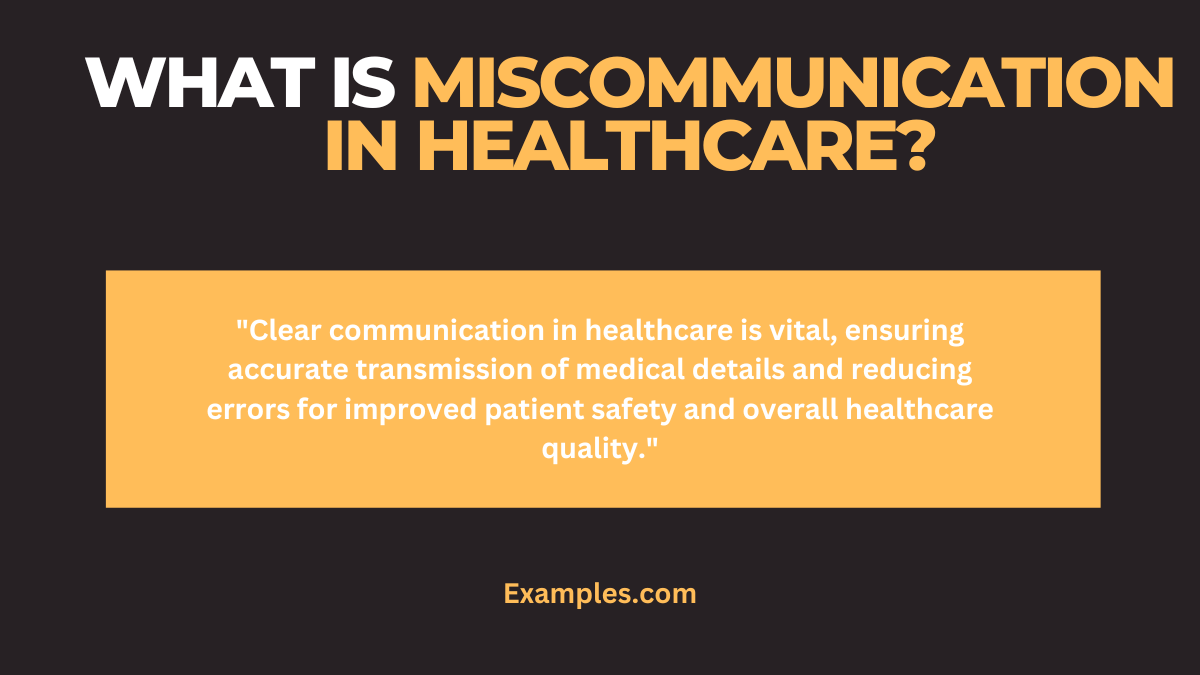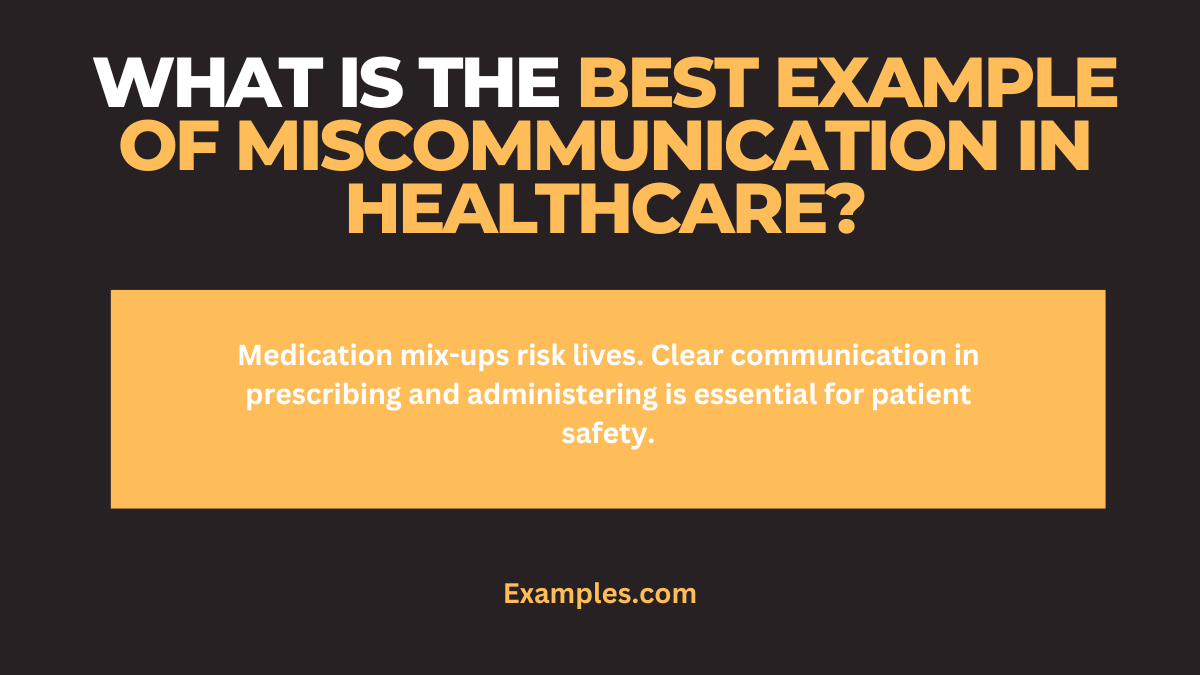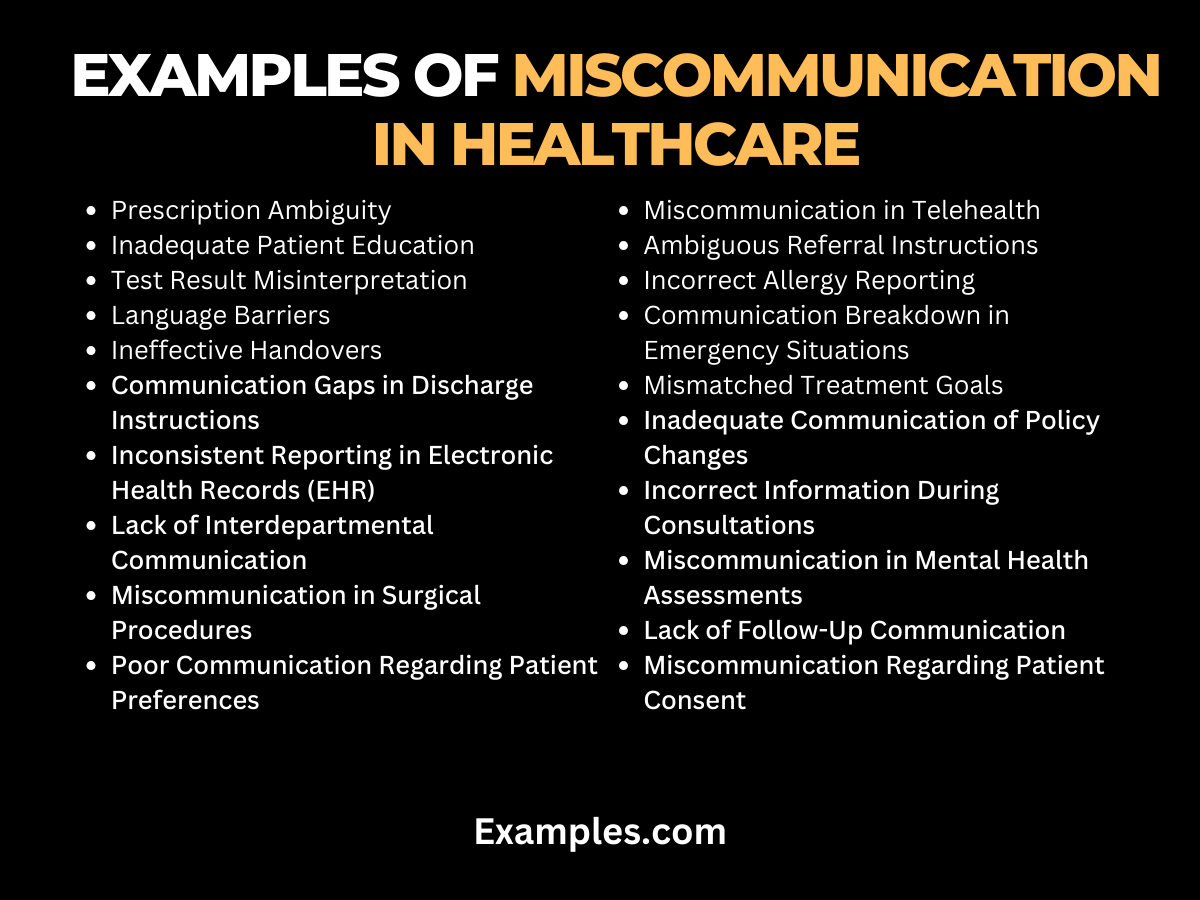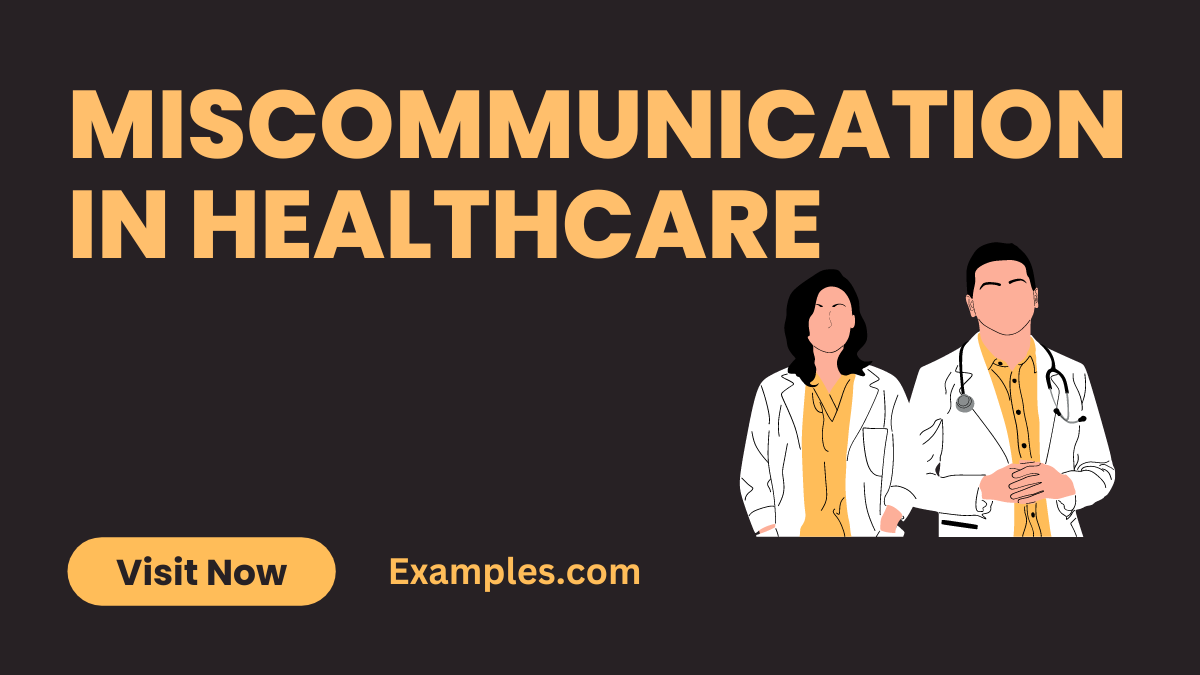Miscommunication in Healthcare
Minimizing miscommunication in healthcare is paramount for patient safety and effective treatment. This comprehensive guide explores strategies to address this critical issue, emphasizing the importance of clear and accurate communication. Delve into real-world “Communication Examples” to understand how proper interaction among healthcare professionals, patients, and stakeholders can enhance overall healthcare outcomes. Learn how fostering a culture of effective communication can mitigate errors, improve patient satisfaction, and contribute to a more efficient healthcare system.
What is Miscommunication in Healthcare? – Meaning And Definition

The term “Lack of Miscommunication in Healthcare” refers to the absence of misunderstandings or errors in conveying information within the healthcare system. In simple terms, it signifies clear, accurate, and effective communication among healthcare professionals, patients, and other stakeholders. This ensures that crucial information about diagnoses, treatment plans, and other medical details is conveyed accurately, reducing the risk of errors that could compromise patient safety and overall healthcare quality.
What is the best Example of Miscommunication in Healthcare?

One poignant example of miscommunication in healthcare involves medication mix-ups, a serious issue with potential life-threatening consequences. This occurs when healthcare professionals misunderstand prescription details or fail to communicate effectively during transitions of care. For instance, a patient may receive the wrong medication due to unclear handwriting on prescriptions or misinterpretation of verbal orders. Such miscommunication underscores the critical need for precise communication in prescribing, dispensing, and administering medications to ensure patient safety and well-being.
30 Miscommunication in Healthcare Examples:

Navigating the intricacies of healthcare communication is crucial to prevent errors. Instances of miscommunication abound, from unclear patient instructions to disjointed handovers. Understanding these scenarios is vital for fostering a culture of precise communication.
Examples:
- Prescription Ambiguity:
Cause: Illegible handwriting or unclear dosage instructions.
Solution: Implement electronic prescriptions for clarity. - Inadequate Patient Education:
Cause: Lack of clear communication about treatment plans.
Solution: Enhance patient education initiatives. - Test Result Misinterpretation:
Cause: Misunderstanding complex diagnostic findings.
Solution: Encourage detailed result discussions. - Language Barriers:
Cause: Communication gaps due to language diversity.
Solution: Employ multilingual staff or interpreters. - Ineffective Handovers:
Cause: Poor communication during shift changes.
Solution: Implement standardized handover protocols. - Miscommunication in Telehealth:
Cause: Technical glitches or misunderstood virtual interactions.
Solution: Provide training for virtual communication. - Ambiguous Referral Instructions:
Cause: Vague details in referral notes.
Solution: Standardize referral communication. - Incorrect Allergy Reporting:
Cause: Patient misunderstanding or incomplete information.
Solution: Emphasize accurate allergy documentation. - Communication Breakdown in Emergency Situations:
Cause: Inadequate relay of critical information.
Solution: Conduct regular emergency response drills. - Mismatched Treatment Goals:
Cause: Varied interpretations of treatment objectives.
Solution: Establish clear treatment outcome criteria. - Communication Gaps in Discharge Instructions:
Cause: Unclear post-discharge care information.
Solution: Provide written, easily understandable discharge plans. - Inconsistent Reporting in Electronic Health Records (EHR):
Cause: Data entry errors or incomplete updates.
Solution: Train staff on accurate EHR documentation. - Lack of Interdepartmental Communication:
Cause: Siloed information among healthcare departments.
Solution: Foster interdisciplinary collaboration and communication. - Miscommunication in Surgical Procedures:
Cause: Inadequate pre-operative briefings.
Solution: Implement standardized surgical checklists. - Poor Communication Regarding Patient Preferences:
Cause: Overlooking patient preferences in treatment decisions.
Solution: Emphasize patient-centered care discussions. - Inadequate Communication of Policy Changes:
Cause: Poor dissemination of updated healthcare policies.
Solution: Establish clear channels for policy communication. - Incorrect Information During Consultations:
Cause: Misinterpretation of patient history.
Solution: Encourage patients to clarify information during consultations. - Miscommunication in Mental Health Assessments:
Cause: Difficulty expressing nuanced mental health issues.
Solution: Train healthcare professionals in empathetic communication. - Lack of Follow-Up Communication:
Cause: Failure to communicate post-treatment follow-up plans.
Solution: Implement automated follow-up reminders. - Miscommunication Regarding Patient Consent:
Cause: Misunderstanding or insufficient explanation.
Solution: Ensure comprehensive informed consent discussions. - Miscommunication in Mental Health Assessments:
Cause: Challenges in conveying subjective experiences.
Solution: Prioritize comprehensive mental health training. - Unclear Discharge Instructions:
Cause: Incomplete or confusing post-treatment guidance.
Solution: Standardize discharge communication practices. - Information Overload in Patient Consultations:
Cause: Overwhelming patients with complex information.
Solution: Break down information into digestible segments. - Inadequate Updates in Electronic Health Records (EHR):
Cause: Failure to update EHR in real-time.
Solution: Train staff on efficient EHR use. - Miscommunication Regarding Dietary Restrictions:
Cause: Inaccurate transmission of dietary needs.
Solution: Establish clear channels for dietary information. - Lack of Communication about Medication Side Effects:
Cause: Incomplete discussion about potential side effects.
Solution: Prioritize comprehensive medication counseling. - Miscommunication During Telemedicine Prescriptions:
Cause: Challenges in accurately assessing patient conditions.
Solution: Develop guidelines for virtual prescription practices. - Patient Non-Adherence Due to Miscommunication:
Cause: Poor understanding of treatment plans.
Solution: Implement adherence support programs. - Miscommunication in Emergency Room Triage:
Cause: Inaccurate assessment of urgency.
Solution: Enhance triage communication protocols. - Limited Communication Training for Healthcare Professionals:
Cause: Insufficient emphasis on communication skills.
Solution: Integrate communication training into professional development.
What is miscommunication in healthcare?
Miscommunication in healthcare refers to instances where information is inaccurately conveyed or misunderstood within the healthcare system. This can occur at various levels, including interactions between healthcare professionals, between professionals and patients, and during transitions of care. The consequences of miscommunication can range from minor errors to severe, potentially life-threatening consequences, making it a critical concern for patient safety and the overall efficacy of healthcare delivery.
Why is Communication an Issue in Healthcare?
Communication poses a significant challenge in healthcare due to several factors:
- Complexity of Medical Information: Healthcare involves intricate medical terminology and complex information. Misunderstandings can arise when professionals assume a common understanding, leading to errors in diagnoses, treatment plans, and patient care.
- Diversity of Healthcare Professionals: The multidisciplinary nature of healthcare means that professionals with varied backgrounds and expertise collaborate. This diversity can result in differences in communication styles, leading to potential misunderstandings.
- Time Constraints and High Workload: Healthcare professionals often work in fast-paced environments with heavy workloads. In such conditions, there is a risk of rushed communication, incomplete handovers, and overlooked details, increasing the likelihood of miscommunication.
- Technological Challenges: The adoption of electronic health records (EHRs) and other technologies introduces new communication challenges. Technical issues, misinterpretation of digital data, or lack of proficiency in using healthcare technology can contribute to miscommunication.
- Patient-Provider Dynamics: Effective communication between healthcare providers and patients is crucial. However, factors such as language barriers, health literacy issues, and varying levels of patient engagement can hinder clear and accurate communication.
Addressing the Challenges:
- Training and Education: Implement comprehensive communication training programs for healthcare professionals to enhance their skills in conveying and interpreting medical information accurately.
- Standardized Protocols: Develop and enforce standardized communication protocols, especially during transitions of care, to ensure consistent and clear information exchange.
- Technological Integration: Invest in user-friendly healthcare technology and provide training to healthcare professionals to minimize the risk of technological miscommunication.
- Cultural Competence: Foster cultural competence among healthcare professionals to address language barriers and diverse communication styles, promoting effective interactions with patients from various backgrounds.
- Patient Education: Prioritize patient education to improve health literacy, ensuring that patients can actively participate in discussions about their care and understand treatment plans.
In conclusion, recognizing the nuances of miscommunication in healthcare and addressing these challenges through strategic interventions is crucial for promoting patient safety, improving healthcare outcomes, and fostering a culture of clear and effective communication within the healthcare system.
Effects of Poor Communication in Healthcare
Miscommunication in healthcare can have profound and far-reaching effects, impacting various aspects of patient care and overall healthcare outcomes. Understanding the repercussions of poor communication is essential for mitigating risks and improving the quality of healthcare delivery.
Effects of Poor Communication in Healthcare:
- Medical Errors and Adverse Events: Miscommunication contributes significantly to medical errors, including prescription mistakes, incorrect diagnoses, and procedural errors. These errors can lead to adverse events, causing harm to patients and compromising their safety.
- Delayed or Inappropriate Treatment: Inaccurate transmission of information can result in delays in treatment or the administration of inappropriate interventions. This can impede recovery and exacerbate health conditions.
- Compromised Patient Safety: Poor communication increases the likelihood of patient safety breaches. Failure to convey critical information, such as allergies or previous adverse reactions, can expose patients to unnecessary risks during medical procedures or treatments.
- Reduced Treatment Adherence: Ineffective communication can lead to confusion about treatment plans, medications, or follow-up instructions. This confusion may contribute to patients not adhering to prescribed treatments, impacting their overall health outcomes.
- Breakdown in Continuity of Care: Miscommunication during transitions of care, such as handovers between shifts or transfers between healthcare settings, can result in a breakdown in the continuity of care. This lack of seamless information transfer can lead to gaps in patient care.
- Increased Healthcare Costs: Addressing the consequences of miscommunication, such as treating complications resulting from errors, can escalate healthcare costs. Preventable medical errors contribute to the financial burden on healthcare systems.
- Legal and Ethical Implications: Miscommunication may have legal ramifications, with patients or their families pursuing legal action in the event of adverse outcomes. Additionally, ethical concerns may arise when communication breakdowns compromise patient autonomy or informed consent.
- Diminished Patient Satisfaction: Poor communication negatively affects patient experience and satisfaction. Feeling unheard or uninformed can lead to dissatisfaction and erode trust between patients and healthcare providers.
- Impact on Healthcare Professionals: Healthcare professionals may experience increased stress, burnout, or job dissatisfaction when dealing with the consequences of miscommunication. Addressing communication challenges can contribute to a healthier work environment.
- Public Perception and Reputation: Repeated instances of miscommunication can damage the reputation of healthcare organizations and professionals in the eyes of the public. Trust in the healthcare system may erode, impacting community relationships.
Mitigating the Impact:
- Communication Training Programs: Implement comprehensive training programs to enhance communication skills among healthcare professionals.
- Technological Solutions: Invest in and optimize healthcare technologies to facilitate clear and efficient information exchange.
- Quality Improvement Initiatives: Establish continuous quality improvement processes to identify and rectify communication-related issues.
- Patient Engagement Strategies: Actively involve patients in discussions about their care, ensuring they understand and participate in decision-making processes.
- Open Communication Culture: Foster a culture of open communication within healthcare organizations, encouraging feedback and transparent information exchange.
recognizing the multifaceted effects of poor communication in healthcare is pivotal for implementing targeted interventions that enhance communication practices, improve patient outcomes, and fortify the overall quality of healthcare deliver
Addressing the lack of miscommunication in healthcare is paramount for patient safety and quality of care. By understanding examples, recognizing signs, and comprehending the effects of poor communication, healthcare professionals can implement targeted solutions. Prioritizing clear communication, standardized protocols, and ongoing training is crucial to fostering a culture that ensures effective healthcare delivery and positive patient outcomes.



